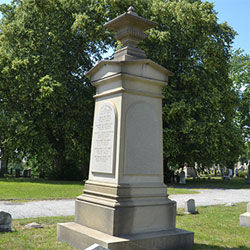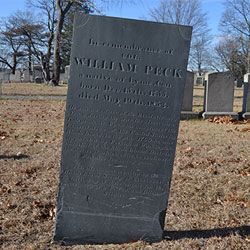
War of Independence
Home Page #2
Battle of Rhode Island & Casualties of War


Home Page #1 (linked): Albany to Yorktown and The Gaspee Affair
Home Page #3 (linked): War at Sea and First Baptist Church


Warning! None of the names below are attached to the gravestones! If someone comes along at a later date to add a gravestone ALPHABETICALLY, all of the names will shift to the wrong gravestones. Either re-do the galleries to attach names to gravestones, or add any new gravestone to the end of the gallery.
Growing Discontent
No one would ever come forward with information about the incident, despite the £1000 reward offered by the king. The British government considered the affair to be treason, and perhaps an act of war, but authorities in Rhode Island, led by Chief Justice Stephen Hopkins, refused to cooperate in the investigation. The events caused a major stir in the colonies and led to inter-colonial discussions of how to respond to the incensed British authorities between key revolutionary figures like Hopkins, John Adams and Samuel Adams.
In 1774 the colonies sent delegates to the First Continental Congress in Philadelphia. Stephen Hopkins and his political rival in Newport, Samuel Ward, represented the people of Rhode Island. This group organized the formal boycott of British goods as a protest against the Coercive Acts. Hopkins also served in the Second Continental Congress and signed the Declaration of Independence.
The Battle of Rhode Island
By the end of the war the 1st and 2nd Rhode Island line regiments had participated in battles from Bunker Hill to Yorktown. Units of both participated in the Battle of Rhode Island (August 8 to August 30, 1778), which was fought in Newport, Portsmouth and Tiverton and was the most significant local clash of the Revolution. John Angell, Charles Laurens Bogman, Stephen Harris, Samuel Healy, Aaron Man, Henry Randall, Daniel Smith, Jabez Whipple, Ceesar Wheaton are among those in North Burial Ground clearly identified as rank and file soldiers in the “expedition to Rhode Island.” Washington placed Major General John Sullivan in command, his Deputy Adjutant General was Colonel William Peck and Assistant Quartermaster General was Dexter Brown. Israel Angell commanded the combined elements of the 1st and 2nd Rhode Island Regiments with Christopher Greene. The “Black” 1st Rhode Island Regiment played a pivotal role in the battle. While the battle itself is considered to be inconclusive to the outcome of the Revolution, not long after it, British forces left Newport.

Israel Angell
John Angell
Charles Bogman
Dexter Brown
Nicholas Cooke
Stephen Harris
Samuel Healy
Aaron Man
William Peck
Henry Randall
Daniel Smith
Ceesar Wheaton
Jabez Whipple
The War for Independence
At least 300 Rhode Islander’s buried in the North Burial Ground helped win independence. During the years 1775 through 1781 North Burial Ground residents fought battles on land and sea, tended the wounded, and endured imprisonment. Many more revolutionary veterans are interred in North Burial Ground than are identified in the narrative that follows, but those we chose are representative of the veterans who fought in the War of Independence.
After the Battles of Lexington and Concord, the Siege of Boston began. The Continental Congress asked each colony to contribute “Continental Line” Regiments to a continental army commanded by Washington. Charles Haskell, an African American, served as a soldier of the Massachusetts Line within the Continental Army. Simeon Thayer of Providence raised a local company that marched to Boston and took their place in the Rhode Island Line. Silvanus Martin, living in Windsor, Connecticut at the time, marched with the Connecticut forces that became part of Washington’s army at Boston. Martin left a terse diary of the events at Bunker Hill in June 1775.
There was a great deal of fluidity within the military organization of the American forces. Regiments and local and county companies were often combined, merged or otherwise blended as combat, illness and expired enlistments took their toll. Some state and local units remained detached. William Barton served in both continental line regiments and state militias. In July 1777, Barton led nearly forty Rhode Island militia and line regiment soldiers on a raid that captured British General Richard Prescott, the British forces commander in Rhode Island, who, ignominiously, was captured twice by American forces during the Revolutionary War.
The Rhode Island Continental Line units came to include the 1st and 2nd Rhode Island Regiments. The 1st Rhode Island Regiment had two incarnations. Originally formed from units that marched to Boston as “Varnum’s Regiment” in May 1775, by June 1775 it was re-designated the 9th Rhode Island Continental, with James Mitchell Varnum in command. In 1777 Washington’s army was re-organized again and the 9th was designated the 1st Rhode Island Regiment, commanded by Colonel Christopher Green until the regiment was merged with the 2nd.
The 2nd Rhode Island Regiment was formed in 1775 from the Providence County militia under command of Daniel Hitchcock. In January 1776 it was designated the 11th Continental Regiment. In September 1776 the 11th was re-designated the 2nd Rhode Island Regiment and when Hitchcock died in January 1777, Colonel Israel Angell became the 2nd Rhode Island’s commander.
Due to losses suffered during 1776 and 1777, while at Valley Forge in the winter of 1777-78 the 1st R.I. Regiment was merged into the 2nd R.I. Regiment. The officers of the 1st were dispatched to Rhode Island to recruit more soldiers for the regiment. In 1778 Governor Nicholas Cooke informed the Continental Congress that the Rhode Island General Assembly had authorized the 1st Rhode Island to recruit slaves into its ranks. The 1st Rhode Island became known as the “Black” Regiment. Colonel Christopher Greene remained in command. Later in the war, when Greene was killed in 1781 at Croton River, New York, Jeremiah Olney replaced him as commanding officer.
POWS
Some patriots such as David Arnold, Allen Brown, Oliver Jillson, and Henry Harris Tillinghast were taken as prisoners; they were sometimes exchanged or died in British prison ships such as the notorious Jersey in Wallabout Bay in New York’s East River, which was the fate of David Dunwell.

























